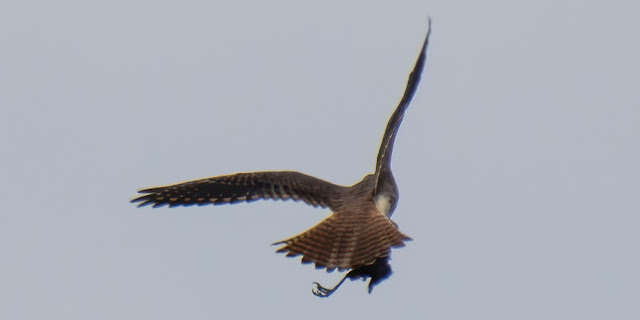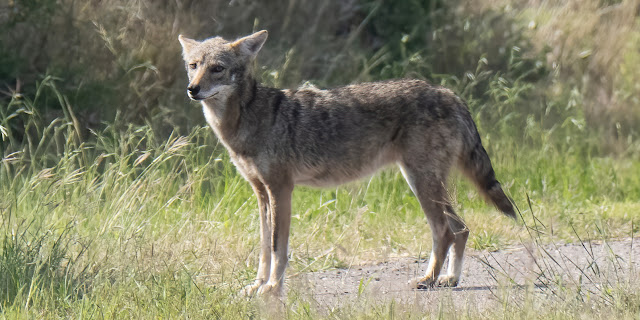 |
| The dunes at South Padre Island |
So, as soon as Henry dropped us off at our cars, I turned around and headed back. First, I went to "the Aplomado Falcon Viewing Area," which is another part of Laguna Atascosa NWR, just down the road from the South Texas EcoTourism Center.
If you plan to stop at the viewing center, be aware that Highway 100 is divided by concrete barriers with very few breaks. If you are traveling west, watch carefully. If you miss the turn, it is several miles until you get another chance. Take it from someone who knows.
Evening at Laguna Atascosa
Then, on to the Laguna Atascosa Visitor Center. I couldn't do the Steve Thompson Wildlife Drive again. But, our tour had not stopped at the bird blinds and paths at the Visitor Center, where I had had good luck with Green Jays, Great Kiskadees, Golden-fronted Woodpeckers, Altamira Orioles and a Common Pauraque the first time I went in 2018.
I headed back over the bridge, where I should have stopped to take pictures of the incredible turquoise water.
Then, I drove about 25 more minutes to the VC parking lot at Laguna Atascosa.
The VC wasn't open and it appeared that the feeders in the blinds hadn't been filled recently. So, the bulk of the birds were lots and lots of very noisy Great-tailed Grackles and some White-winged Doves. I walked around and didn't see anything much ...
 |
| ... except a lovely Brown-headed Cowbird |
It was too late to drive the Refuge's Lakeside Drive, which is still open to automobiles in the daytime, so I took off to explore the road just past the Refuge.
Almost immediately, I saw a Greater Roadrunner by the side of the road.
 |
| Just chillin' |
Then, I drove a little further and, as I drove by, I saw a small raptor out of the corner of my eye. It was sitting on a log very close to the road. My first thought was that it was an American Kestrel. I had driven too far, so I stopped and backed up to get a photo.
 |
| Of course, it flew (with its prey) before I could get a shot |
I saw it land on top of a distant palm, where it was eating the hapless bird it had snagged.
 |
| No big deal, I have lots of nice photos of Kestrels |
I turned around where the road ended at a private ranch road, deciding two things: not much was happening, so I would head back to the hotel and that I would come back early the next morning before heading home. I also decided to cancel my next night's lodging nine hours away to give myself some leeway for exploring on the way home.
I stopped to photograph another Scissor-tailed Flycatcher ...
 |
| You just can't resist these beauties |
... and then I started thinking (or over-thinking) ...
I had only a brief glimpse of that raptor up close. Despite the crops seen here, my photos were distant and hard to see on my camera with tired, dusty eyes. I wasn't really sure what an Aplomado Falcon looked like (I mean, you saw how far away the ones I saw earlier were). And, Javier had said they were small, with long tails.
I convinced myself that that bird could have been an Aplomado. So, I went back and found it on another palm, this one a bit closer.
 |
| I took a million photos |
And, then, looking again, I realized I had been right in the first place.
 |
| It was, indeed, an American Kestrel; sometimes, wishing almost makes it so |
 |
| Was this bird mocking me? It is, after all, a Northern Mockingbird |
Oh, well, I'd look in the morning.
I stopped briefly on the way back to photograph a Crested Caracara, but I am not sure the trip back out was worth it.
 |
| Always on the power poles |
Final Morning in South Texas
I got up early the next morning, realizing that I hadn't even seen the Gulf beach at South Padre.
 |
| Sunrise on the beach |
I had brought my bathing suit, but the wind was so intense, the beach didn't seem that appealing.
 |
| It is always like this |
I drove to the end of the road, avoiding sand that had drifted over the road during the night.
To quote Texas Monthly, "The sand dunes of South Padre Island have a mind of their own; drive up State Park Road 100 long enough and the beach comes to meet you."
David Hicks, director of the School of Earth, Environmental and Marine Sciences at the University of Texas Rio Grande Valley, said, "Dunes are ephemeral structures engaged in a battle, with the wind trying to move the sand and the plants trying to keep it in place."
 |
| Dunes |
Sand blowing off the Gulf beaches forms the dunes lining the island's eastern shore.
 These "fore-island dunes" form a critical natural dike that prevents storm tides from destroying the grasslands. In essence, these dunes are the "barrier" in the term "barrier island."
These "fore-island dunes" form a critical natural dike that prevents storm tides from destroying the grasslands. In essence, these dunes are the "barrier" in the term "barrier island."The end of the South Padre Island is State Park land (nearby, but a long drive away, is Padre Island, which is a National Seashore). I drove the road, but didn't drive to any of the beaches.
I didn't see much wildlife, except a little Sparrow (Vesper Sparrow? Lark Bunting? I am not sure) that was walking drunkenly along the roadside.
 |
| I guess it just landed after flying across the Gulf; it certainly looked tired |
I knew I didn't have a lot of time (I mean, I had to go home eventually), so I headed out.
Back to Laguna Atascosa
As I drove in during the early morning, I hoped to see an Ocelot. I didn't. I did see some Altamira Orioles and a Golden-fronted Woodpecker on the wires.
 |
| I just got the Oriole |
Of course, there still was no food in the feeders in the blinds, so the bird population was roughly the same. Except, I did get a photo of a White-tipped Dove.
 |
| I had seen them before, but never gotten a photo, so that was a plus |
 |
| There was also a cute little Desert Cottontail in the blind |
 |
| An Olive Sparrow hiding in the bushes |
 |
| Northern Cardinal in the trees |
I don't know if they cut back hours or if they don't have enough volunteers or donated food (volunteers often stock bird blinds at National Wildlife Refuges and State Parks). But, anyway, there wasn't much to draw birds to the blinds.
So, I moved on, stopping briefly to photograph a common butterfly for the area, an American Snout. I had also seen some of these tiny butterflies at the Santa Margarita Ranch, but had not gotten a photo.
 |
| The reason for the name is obvious |
Lakeside Drive was a total bust, nothing to see but a couple of Black-bellied Whistling Ducks on the wing.
The tide was so far out at the lagoon overlook that I couldn't see anything.
Oh, well, I really had to move on, so this might have been a blessing.
Of course, I drove back to where I had seen the Kestrel the night before (if Kestrels hunt there, then so, too, could Aplomados). Nothing.
But I did stop to watch some more Altamira Oriole nest-building.
 |
| Bringing in some grass to weave |
 |
| It is fascinating to watch |
But, time to move on.
 |
| Both the Oriole and I had to fly |
As I was leaving, I saw an animal cross the road. My heart leapt, thinking that it was an Ocelot ... No. An Gray Fox? No.
Just a Coyote.
Most people don't know that Coyotes (and Rabbits and Elk and Bears and so many other animals) have subspecies found in different areas. Coyotes have 19. This was a Lower Rio Grande Coyote, the smallest of all Coyote subspecies.
 |
| I also thought it might be a ranch dog |
They usually weigh no more than 30 lbs. In contrast, the Mountain Coyote that we have where we live can weigh up to 50 lbs.
A nice sighting as I drove north.







No comments:
Post a Comment